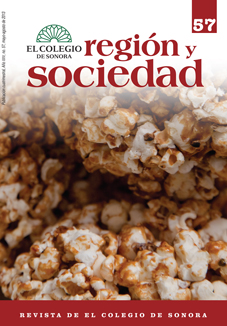 |
 |
 |
 |
 |
 |
 |
 |
 |
 |
 |
 |
Abstract
The structural analysis of the economy of Baja California, from network theory, is based on the implementation of an innovative technique with a quantitative focus which makes it possible to highlight the most outstanding features of a productive network in a coherent and simplified way; in addition, the particular characteristics of this new technique and their incorporation into economic analysis pose a challenge to the study of the productive structure at a regional or national level.
References
Bavelas, A. 1948. A Mathematical Model for Group Structure. Human Organizations 7: 16-30.
Borgatti, Steve. 2003. Conceptos básicos de redes sociales. Material del taller impartido en Cancún Quintana Roo. 42.
Chenery, Hollis Burnley y Tsunehiko Watanabe.1958. An International Comparison of the Structure of Production. Econométrica 26: 487-521.
De Ugarte, David. 1999. Analizando redes sociales. www.lasindias.com/curso_redes/index.html
Freeman, Linton C. 1979. Centratility in Social Networks. Conceptual Classification. Social Network 1.
Friedkin, Noah E.1991.Theoretical Foundations for Centrality Measures. The American Journal of Sociology 96 (6): 1478-1504.
García, Ana Salomé. 2006. La teoría de redes en análisis input-output. Tesis doctoral, Universidad de Oviedo.
---------- y Carmen Ramos. 2007. Core/Periphery Structure Models: An Alternative Methodological Proposal. Social Networks 28: 442-448.
----------, 2003. Las redes sociales como herramienta de análisis estructural input-output. Revista Hispana para el Análisis de Redes Sociales 4 (5): 1-21.
---------- y Antonio Morillas. 2006. Relaciones interindustriales y difusión de la innovación. Una aproximación desde la teoría de redes. Estadística Española 160: 475-499.
Garrido, E. J. 2001. El análisis de redes en el desarrollo local. En Prácticas locales de creatividad social, tomo 2, Construyendo ciudadanía, editado por T. R. Rodríguez Villasante, M. Montañés y P. Martín, 49-63. Barcelona: El Viejo Topo.
Granovetter,Mark.1973.The Strengthof Weak Ties. American Journal of Sociology 78 (6): 1360-1380.
Hanneman, Robert. 1997. Introduction to Social Network. Departamento de Sociología de la Universidad de California, Riverside. Disponible en versión electrónica en Methods. http://faculty.ucr.edu/~hanneman/Soc157/text/TextIndex.html.
Herrero, Reyes. 2000a. La terminología del análisis de redes. Problemas de definición y de traducción. Política y Sociedad 33: 199-206.
----------, 2000b. La centralidad en las redes sociales. Clarificación conceptual. Política y Sociedad 33: 131-148.
Kemeny, John y Laurie Snell. 1960. Finite Markov Chains. Londres: D. Van Nostrand Co. Ltd.
Molina, José Luis. 2000. El análisis de redes sociales. Aplicación al estudio de la cultura en las organizaciones. Tesis doctoral, Universidad Autónoma de Barcelona.
Morillas, Antonio. 1995. Aplicación de la teoría de grafos al estudio de los cambios en las relaciones intersectoriales de la economía andaluza en la década de los 80. Cuentas Regionales e input-output, Instituto de Estadística de Andalucía.
----------, 1983. La teoría de grafos en el análisis input-output. La estructura productiva andaluza. Málaga: Editorial Universidad de Málaga.
Nieminen, J. 1974. On the Centrality in a Graph. Scandinavian Journal of Psychology 15 (1): 332-336.
Rasmussen, P. Noregaard. 1956. Studies in Intersectorial Relations. Amsterdam: North-Holland Publishing Co.
Sabidussi, G. 1966.The Centrality Index of a Graph. Psychometrica 31: 581-603.
Streit, Maurice E. 1969. Spatial Associations and Economic Linkages Between Industries. Journal of Regional Science 9: 177-188.
Open access policy
The authors who publish in región y sociedad accept the following conditions:
In accordance with the copyright laws, región y sociedad recognizes and respects the authors’ moral rights, as well as the ownership of property rights, which will be transferred to the journal to disseminate the articles in open access. región y sociedad does not charge the authors for submitting and processing articles for publication.
All the texts published by región y sociedad —with no exception— are distributed under a Creative Commons license 4.0 Attribution – Noncommercial (CC BY-NC 4.0 International), which allows third parties to use the publication as long as they mention the works’ authorship and the first publication in this journal.
The authors can enter into independent and additional contractual agreements for the nonexclusive distribution of the version of the article published in región y sociedad (for instance include it into an institutional repository or publish it in a book) as long as they clearly indicate that the work was published for the first time in región y sociedad.
For all the above, the author(s) must send the Letter of transfer of property rights of the first publication duly filled in and signed by the author(s). This letter can be sent by e-mail as a PDF to: region@colson.edu.mx






